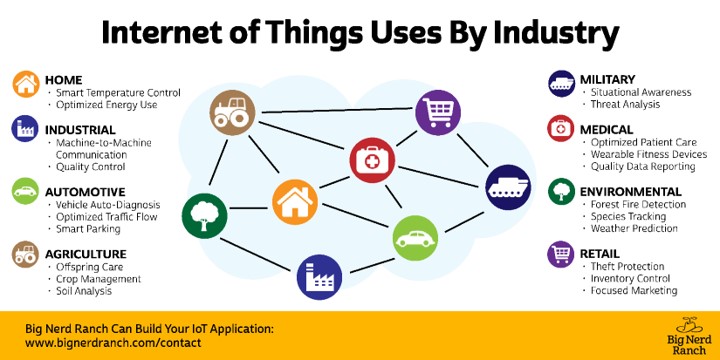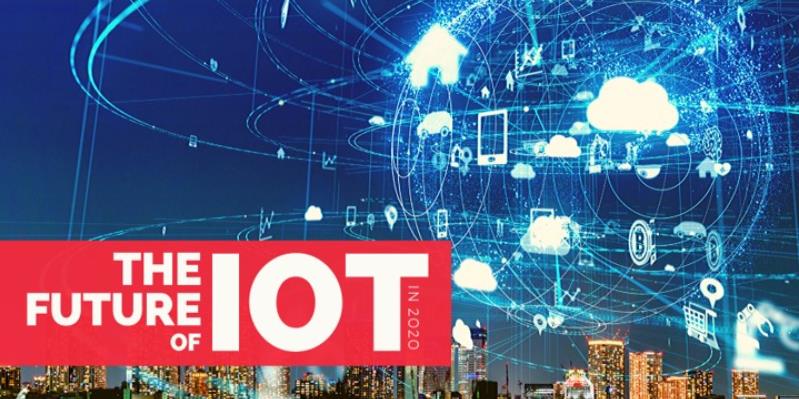The Future of IoT in 2020
What would life be without the internet?
This generation will probably never know. But those who lived before 1991 when the Internet was made public, might vaguely remember the era of the analog and the manual, where mentioning appliances “talking” to each other as the stuff of the next futuristic fiction film. And yet, here we are today, in a world where everyone can be connected through the internet, realizing that if we could connect to the internet through our mobile devices, then we could probably connect our TV, our microwave, and even our beloved coffeemaker. With the Internet of Things or IoT, yes, we can.
IoT technology can encompass everything connected to the internet. "Simply, the Internet of Things is made up of devices – from simple sensors to smartphones and wearables – connected together," according to Matthew Evans, the IoT program head at techUK.
According to TDengine, by automating and combining these smart devices, it is possible for these devices to be programmed, gather more information analyse it through machine learning technology, that creates an action or appropriate response to help people with performing tasks, or learning processes, or analysing more data.
The Controversy of Data Sharing in IoT
In a time when data is as precious a commodity as gold, highly sought after not just by marketing agencies or business owners but also by cyber misfits far and wide, the global community is not yet fully at peace with the need for data sharing for IoT devices to work.
Cyberattacks—like drive-by attacks where hackers can invade these kinds of systems even from 300 meters away to implant malware or take control of devices for whatever fraudulent intent they may have—we have legitimate reasons to keep questioning and challenging technologies such as this for our good and security.
But despite these vulnerabilities, Internet of Things and its IoT devices are becoming more and more popular, as people pursue greater connectivity, efficiency, and control.
Evans adds that "IoT offers us the opportunity to be more efficient in how we do things, saving us time, money and often emissions in the process." It allows businesses and governments to streamline their services and their products for the benefit of the people they serve, whether as a public service or for commercial purposes. It seeks to do good, and so it is worth trusting as we move deeper into the future.
Some Applications of IoT Technology Today

The growth of installed IoT devices will likely outpace that of other devices in the coming years. Gartner predicts that the number of smartphones, laptops, and tablets in use worldwide will hit 7.3 billion units this 2020. Here is one way IoT is already being used today.
- Smart Home The Smart Home is the highest-ranking IOT application on all channels. Users of this technology are steadily increasing, with just the searches alone climbing up to 60,000 every month. More startup companies are also getting involved as the database of smart homes for IoT Analytics includes 256 companies and startups. The funding for Smart Home startups is now beyond $2.5 billion and counting.
- Wearable Apple’s smartwatch is probably the most famous wearable to date, but more and more of its kind are being released in the market, such as the Sony Smart B Trainer, the Myo gesture control, and the LookSee bracelet.
- Smart Grids The smart grid uses computer technology to improve the automation, communication, and connectivity of the various components of the power network. This allows bulk transmission of power gathered from multiple generation plants, conservation of energy, reduced power costs, increased reliability and transparency, and more efficient operations.
- Industrial Internet of Things (IIoT) The Industrial Internet of Things is the integration and linking of technologies like big data, analytical tools and wireless networks with physical and industrial equipment, using “meta-level networking” functions, to distributed systems. It is extended use of IoT in the industrial sector, with emphasis on M2M (machine-to-machine) communication, big data, and ML (Machine Learning). IoT in an industrial setting will allow machines like dust collectors to communicate to sensors to regulate and monitor machine usage and effectiveness. It enables industries to have more efficient and reliable operations and includes areas such as robotics, mHealth (mobile health) and software-defined production.
- Connected Car Connected car technology is a vast and extensive network of multiple sensors, antennas, embedded software, and technologies that assist in communication and navigation of smart vehicles. It is responsible for making decisions with consistency, accuracy, and speed, and therefore needs to be reliable. Some most famous brands using this technology is Tesla, with its array of self-driving vehicles, both in production and in its development stages.
- Connected Health (Digital Health/Telehealth/Telemedicine) IoT has different healthcare applications, to connect remote monitoring equipment, to smart sensors, to equipment integration. It is being developed to improve how medical professionals deliver care, monitor their patient’s condition, and even provide consultation without face-to-face meet-ups. Some examples are personal fitness sensors, heart monitors, and surgical robots.
- Smart Retail Smart retail is a set of smart technologies designed to provide customers with a more efficient, safer and smarter shopping experience. With more than half of Internet users doing so through their smartphones or mobile devices, it is not a surprise why online shopping, banking and donating is now a much-preferred eCommerce mode for the current generation.
- Smart Supply Chain Supply chains use IoT technology in the tracking of goods while in transit, or helping suppliers exchange inventory information with each other. With an IoT enabled system, factory equipment with embedded sensors can communicate data like pressure, temperature, and utilization of the machine, to process workflow and change equipment settings to optimize performance.
- Smart Farming Through the Internet of Things, we can monitor remote farming operations and large livestock. IoT can revolutionize the way farmers work. Smart farming can become an important application in agricultural-product exporting countries.
The Future of IoT
- A look at IoT by the year 2025 The amount of IoT devices will increase by 28.7% by 2025. That’s 75.44 billion devices that will be connected worldwide and is expected to produce 79 Zettabytes of information and data.
- The Presence of a Bot in Smart Homes As homes begin to grow smarter, service bots will be utilized more to help in different tasks. The need for bots will, of course, lead to the development of platform companies and creators that will cater and develop the tech and service even further.
- Smart City With the development of smart homes, this will lead to the development of a smart city. The goal is to make life easier. Several cities in the United States are already investing in making smart cities. The smart city will have services that will cater to services accordingly to smart homes, such as waste management and utilities. This will also include better traffic management, better security, and even environmental monitoring, as the city will produce less pollution.
- The Development of 5G IoT Technology needs a better connection to accommodate millions of applications. At the moment, the 4G network is able to support up to 5500 to 6000 NB-IoT devices 5G is central to the IoT for billions of applications. From 2030, IoT devices will grow from 75 billion to 100 billion, and the improvement from 4G to 5G increasing IoT is most important. The 4G network supports up to 5500 to 6000 NB-IoT devices on a single cell, while the 5G network can handle up to one million devices.
- Routers will Become More Secure to Block Unwanted Access The IOD makes your home smarter and efficient when secured from cybercriminals. Positively, home devices connected with the internet like smart TV, security cameras, door locks, and more can add the level of luxury and comfort in your life. Negatively, they can make your home unsafe. The router will play an essential role by securing the entry point of the internet into your home. While your smart IoT device cannot be protected, the router will protect the entry point of the internet by password production, firewalls, and configure them to allow the only specific device on your network.
- More Cars Will Become Smart 75% of cars around the world will connect to the internet, and by 2025, 100% of sold cars will join. Internet of Vehicles (IoV) development relies much on sensors for reading biological data inside the vehicle and environmental data from the outside. Driverless cars could eliminate 85% of head-on collisions. Since the new cars will not require paying a driver, using hire vehicles will become sufficiently cheaper. 54% of US drivers do not feel safe sharing the road with driverless cars.
- Data Analysis Will Increase The expectation is that the individuals will be able to assist in the decisions they need help. AI can quickly identify trends, making IoT able to collect extensive data with better precision and accuracy.
- MHealth or Mobile Health Care Will Further Improve The availability of extensive improves healthcare results greatly. Companies are already working on the IoT technologies that can identify and collect data over cancer, and images readings change in body parameters at different stages of the disease to develop a technology that determines the development of cancerous cells in the body at very early stages.
- Edge Computing Over Cloud Computing Stating simply, all the data from an earlier time sent to the cloud, now it would be to a local device that is near to the IoT one. It will decrease the traffic on the network, and this is ‘edge computing’ because it has several benefits that we will see someday.
- Securing IoT and Connected Devices More and more devices connect to the IoT. It will be crucial to implement security measures as data carrying vital information in terms of banking and health care fields are dumped over the cloud.
Conclusion: IoT is Digital Era’s Next Big Thing
The Internet of Things (IoT) is seen to become the biggest technological breakthrough of this decade, just as smartphones where the biggest breakthrough from the previous one. Many households in the future will own multiple smart devices, appliances, and even vehicles, finally turning Sci-Fi reels into real.
But as with all technology, vulnerabilities are seen to plague IoT as well, like mixed levels of threat with combined OS (operating systems), vulnerabilities in the devices themselves, and IoT breach. But no matter the threats, the benefits far outweigh the risks, and IoT is more than worth pursuing, developing, and adopting in the future.
“The good news, though, is that tried-and-true IT security controls that have evolved over the past 25 years can be just as effective for IoT—provided we can adapt them to the unique constraints of the embedded devices that will increasingly comprise the networks of the future.” —Michel Chabroux, Wind River
Even with technological advancements we already enjoy today, we still need to know the cybersecurity trends and threats so we can keep ourselves secure. We just need to practice the same amount, if not greater, vigilance in our fight against cyber and technological threats, to ensure that the generations now and in the future fully enjoy the benefits of emerging technologies such as the Internet of Things. No matter how advanced technology gets, its main purpose is still to assist man in performing his tasks. Let’s keep it that way by being accountable and responsible with every emerging technology of our time and in that to come.
Related Posts
In the era of high-speed internet, owning a server with a 10Gbps connection offers an unparalleled advantage in terms of data transfer speed, website performance, and user experience.
To make your business successful in the modern age, you need to excel at digital marketing and have a strategy that can allow you to beat out the competition.
In the ever-evolving landscape of digital marketing, link building remains a cornerstone of search engine optimization (SEO).
In today's age, establishing an online brand presence is crucial for success. With the vast reach and accessibility of the internet, launching your brand online can open up endless opportunities for growth and expansion.
Ecommerce marketing relies heavily on understanding consumer behavior and psychology to drive engagement, conversions, and loyalty.
In the world of interior design, ambiance is everything. From the cozy warmth of a rustic farmhouse to the sleek sophistication of a modern penthouse, decor plays a pivotal role in setting the mood and personality of a space.













Comments
comments powered by Disqus